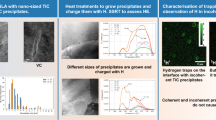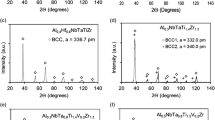Abstract
It is shown that aluminum, Al-Mg-Mn-Fe (Alustar), Al-Mg-Mn-Fe-Si-Cr (PA13), and Al-Zn-Mg-Mn-Fe-Si-Cr (Pa47) alloys are sensitive to hydrogen embrittlement in the course of the tests carried out at low strain rates in a 0.01 N NaOH solution. The stress-strain curves, time to failure, and the character of fracture surfaces of specimens tested in air and under the conditions of cathodic polarization are compared. The parameters of hydrogen transport and its entrapping by hydrogen traps are studied on the basis of the data of electrochemical measurements of hydrogen permeation and vacuum extraction. The morphology of inclusions is estimated by the method of numerical metallography and their chemical composition by the method of EDS analysis. Despite distinctions in the chemical and phase compositions of alloys, we observe the dependence of the sensitivity to hydrogen embrittlement on the parameters of hydrogen transport and its entrapping by irreversible traps and some other microstructural characteristics. Under the conditions of electrolytic hydrogenation, the PA13 alloy reveals hydrogen-enhanced plasticity.
Similar content being viewed by others
REFERENCES
V. M. A. Devanathan Z. Stachurski (1964) ArticleTitleThe mechanism of hydrogen evolution on iron in acid solutions by determination of permeation rates J. Electrochem. Soc. 111 619–623
R. M. Barrer (1941) Diffusion Through and in Solids Univ. Press Cambridge
G. M. Pressouyre I. M. Bernstein (1978) ArticleTitleA quantitative analysis of hydrogen trapping Metal. Trans. 9a 1571–1576
A. Turnbull (1995) ArticleTitleFactors affecting the reliability of hydrogen permeation measurement Mater. Sci. Forum 192 IssueID194 63–78
D. T. DeHoff F. N. Rhines (1973) Quantitative Microscopy McGraw-Hill New York
B. N. Arzamasov (1986) Materials Science Mashinostroenie Moscow
Z. Szklarska-Smialowska, “Susceptibility of steels to hydrogen trapping evaluated by potentiostatic double pulse technique,” in: Polish-Japanese Symp. on the Environmental Effects on High-Technology Materials, Warsaw-Chiba (1997), pp. 131–142.
A. Turnbull M. W. Carroll D. H. Ferriss (1989) ArticleTitleAnalysis of hydrogen diffusion and trapping in a 13% chromium martensitic stainless steel Acta Metal. 37 IssueID7 2039–2046
M. A. Iino (1982) ArticleTitleMore generalized analysis of hydrogen tapping Acta Metal. 30 367–375
E. Lunarska A. Mikeladze (1997) ArticleTitleEffect of second phase particles on hydrogen embrittlement of iron alloys Int. J. Hydrogen Energy 22 IssueID2/3 131–139
Author information
Authors and Affiliations
Additional information
Published in Fizyko-Khimichna Mekhanika Materialiv, Vol. 40, No. 3, pp. 88–94, May–June, 2004.
Rights and permissions
About this article
Cite this article
Lunarska, E., Chernyaeva, O. Effect of precipitates on hydrogen transport and hydrogen embrittlement of aluminum alloys. Mater Sci 40, 399–407 (2004). https://doi.org/10.1007/PL00022004
Received:
Issue Date:
DOI: https://doi.org/10.1007/PL00022004




